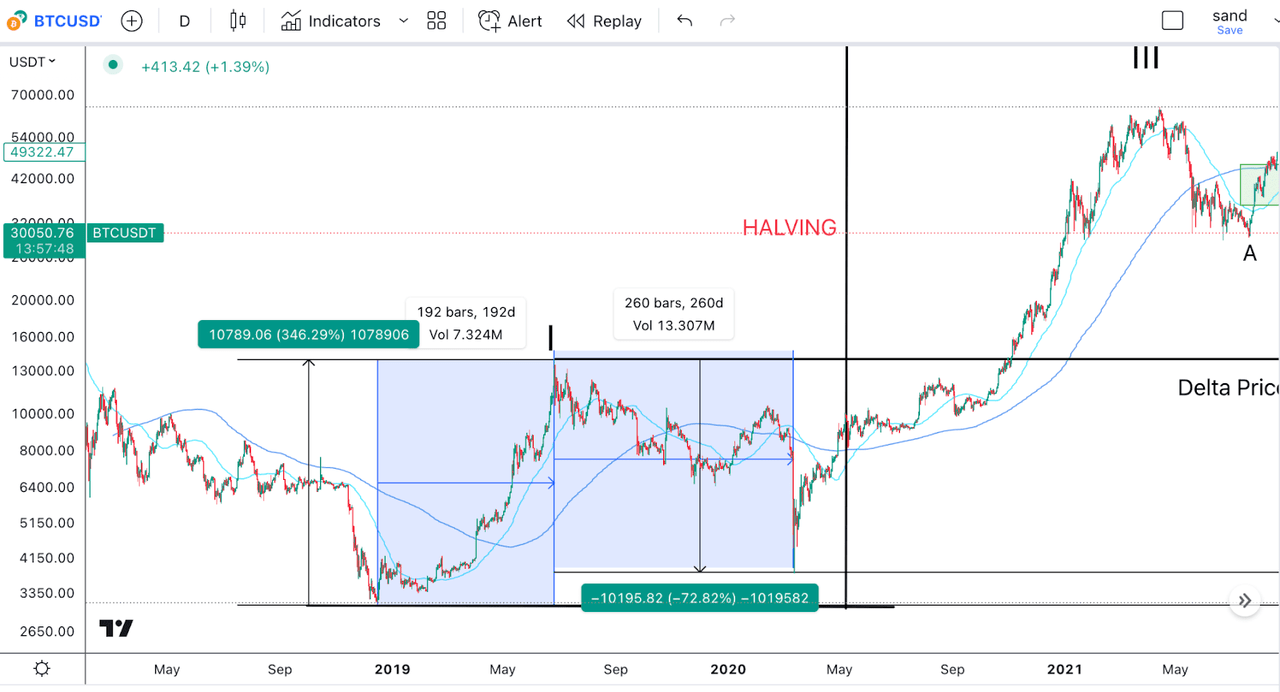Thesis Summary
Bitcoin (BTC-USD) has made a convincing argument over the past few months that a cycle low could be in. However, history shows that we could get a very aggressive pull-back before the Halving takes place.
This view is also reinforced by both technical analysis and macroeconomic analysis of liquidity and the business cycle.
A Mirror Image of 2019?
Let’s begin with a trip down memory lane. This is how Bitcoin behaved leading up to the last halving, which took place on May 11th, 2020.
BTC Previous Cycle Price Action (Author’s work)
As we can see, Bitcoin bottomed at around $3500 just before the start of 2019. The world’s first cryptocurrency then rallied 346% over the next 192 days. Following this, we could characterize the next 260 days as a market correction, with Bitcoin losing 72.83% of its value. This movement was accelerated by the Covid crisis, but from an Elliott Wave perspective, it fits in perfectly as a I-II set-up, which was then followed by an aggressive wave III to the upside.
Here’s the Bitcoin chart now and what the next few months could look like if we assumed a similar behavior:
Bitcoin Price Forecast (Author’s work)
The next halving should happen around April/May 2024. BTC has already nearly doubled since it hit a bottom over 140 days ago. Therefore, BTC could continue to rally over the next almost two months, probably targeting somewhere around the $40K-$50K area. This target was reached using Fibonacci extensions which I have discussed more in-depth with my subscribers.
History would tell us that BTC could reach a top by the end of May and then begin a correction that, once again, using Fibonacci ratios, I believe, could take us back into the $22K area by January 2024.
This would follow a similar time frame as in the past cycle, but the price swings are a bit less aggressive, which makes sense if we think about how Bitcoin’s volatility has diminished with every cycle.
Once again, this move would fit in well with my EW count, which would have us completing a wave 1 and 2 in what would be the larger wave V to the upside.
By itself, this is just a neat little comparison, but I believe this can be supported strongly by macroeconomic fundamentals.
Liquidity Seems to Agree
Liquidity is a determining factor in market movements, and this is especially true of Bitcoin, which is perhaps one of the best liquidity proxies out there.
US Liquidity can be calculated by taking the balance held at the Fed, subtracting the use of the Reverse Repo facility, the Treasury General Account and, as of recently, adding up Fed remittances, which is interest the Fed pays to the Treasury.
From a US perspective, there are a couple of factors that could drain liquidity. First off, as we enter tax season, the TGA will be replenished, which is equivalent to liquidity being sucked out of the market.
This was very eloquently explained by fellow SA contributor Pragmatic Value Investing in this recent article. He estimated that $398 billion in liquidity could be trapped in the next few months.
Another bug drain of liquidity could be the unwinding of the recent loans that the Fed provided to distressed banks. Below we can see Fed assets over the last few months.
Fed Assets (St. Louis Fed)
A lot of noise was made, myself included, about how the Fed loans had undone months’ worth of QT, but we can see how this has quickly reversed in the last few weeks. The fact of the matter is that QT is still in effect, and the economy is still digesting rate hikes from the last few months.
In terms of global liquidity, things could be a bit better, but it’s quite uncertain at the moment how some of the major Central Banks will act in the coming months. The Bank of Japan just changed governors and the Yield Curve Control policy, which has been instrumental in adding liquidity over the past few years, is being put into question.
China has been quite accommodative in its monetary policy, and with low inflation numbers, this could continue, but the country also has to worry about the value of the Yuan, especially as more countries begin to use it in trade.
All in all, expectations are that liquidity could come down over the summer months, and markets could be dragged down with it.
Recession is Coming
And the other big issue we are facing, of course, is the impending recession, which could come as soon as the end of the year. This is clear if we look at leading indicators. Below we can see the rate of change of M2, and the spread between the US10Y note and the Fed Funds rate.
M2 Rate of Change (Swissblock Insights)
Yield Curve (Swissblock Insights)
The collapse in M2 and the inversion of the yield curve are warning signs that a recession is coming.
In recent weeks, we have got more concrete evidence of recession. with coincident indicators such as the non-farm payrolls taking a turn for the worse:
Non-Farm Payroll (TradingView)
It looks like a deflationary recession could be coming soon, and this would drag down markets for sure. Bitcoin could actually hold up a bit better, but I’d still expect it to perform poorly.
Takeaway
It’s quite simple, really. With the recent inflation data, the stage is set for a Fed pause. A rate pause is bullish for assets, and it’s these expectations that are fueling the current rally. However, a recession will drag markets down with it, and based on history, it will only be after the Fed begins to cut that a solid bottom will be formed.
The question is, how far can markets rally before the recession hits? My guess is we can go a bit higher, but we are entering the danger zone. I believe the next few weeks could be a good time to take some profits.
Read the full article here



